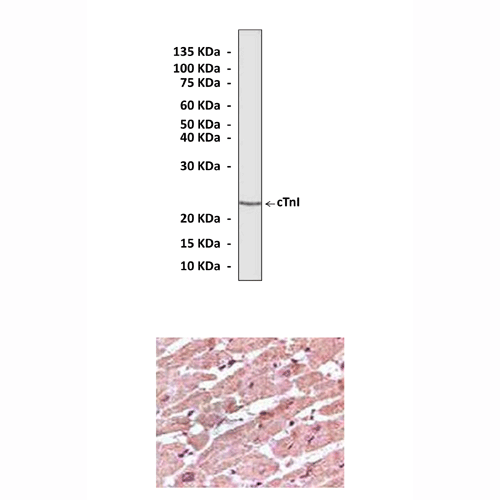Anti-cTnI: Mouse Cardiac Troponin Antibody |
 |
BACKGROUND Troponin I (TnI), along with Troponin T (TnT) and Troponin C (TnC), is one of 3 subunits that form the Troponin complex of the thin filaments of striated muscle, which confers calcium-sensitivity to striated muscle actomyosin ATPase activity. TnI is the inhibitory subunit; blocking actin-myosin interactions and thereby mediating striated muscle relaxation. The TnI subfamily contains three genes: TnI-skeletal-fast-twitch, TnI-skeletal-slow-twitch, and TnI-cardiac. cTnI gene encodes the TnI-cardiac protein and is exclusively expressed in cardiac muscle tissues. Mutations in cTnI gene cause familial hypertrophic cardiomyopathy type 7 (CMH7) and familial restrictive cardiomyopathy (RCM).1
There is evidence for PKC and PKA-dependent multisite phosphorylation of cardiac troponin I (cTnI) at Ser-23 and Ser-24 (also PKA sites) in the cardiac-specific N-terminal extension and at Thr-144, a unique residue in the inhibitory region.2,3 p90RSK is also involved in this phosphorylation process.2 The functional effect of these phosphorylations may be involved in regulation of intramolecular interaction between the N-terminal extension and the inhibitory region of cTnI and depress the acto-myosin interaction. It may be important during the progression of heart failure.
REFERENCES
1. Sleeper, M.M. et al:J. Veterin. Intern Med. 15:501-3, 2008
2. Itoh, S. et al: J. Biol. Chem. 280:24135-42, 2005
3. Chandra, M. et al: Biochem. 36:13305-11, 1997
2. Itoh, S. et al: J. Biol. Chem. 280:24135-42, 2005
3. Chandra, M. et al: Biochem. 36:13305-11, 1997
Products are for research use only. They are not intended for human, animal, or diagnostic applications.
Параметры
Cat.No.: | CP10060 |
Antigen: | Purified recombinant human cTnI proteins expressed in E. coli. |
Isotype: | Mouse IgG1 |
Species & predicted species cross- reactivity ( ): | Human, Mouse |
Applications & Suggested starting dilutions:* | WB 1:500 - 1:1000 IP n/d IHC 1:200 - 1:1000 ICC n/d FACS n/d |
Predicted Molecular Weight of protein: | 23 kDa |
Specificity/Sensitivity: | Detects cTnI proteins without cross-reactivity with other family members. |
Storage: | Store at -20°C, 4°C for frequent use. Avoid repeated freeze-thaw cycles. |
*Optimal working dilutions must be determined by end user.
Документы
Информация представлена исключительно в ознакомительных целях и ни при каких условиях не является публичной офертой








